When eight people were killed in Atlanta, six of them women from the Asian American and Pacific Islander communities, an organization for journalists was prepared to call out stereotypes and offer guidance.
They’d been doing it for so long already.
The shootings started at 4:54 p.m. on March 16. By 8 p.m., the white man responsible for the killings was in police custody. That night and into the next morning, the Asian American Journalists Association worked to offer mental health support to members.
Then, they started seeing the coverage.
“We all immediately knew what the messaging had to be,” said AAJA president and Washington Post reporter Michelle Ye Hee Lee.
AAJA had to do three things after the shootings: support members, offer historical context about anti-Asian violence and call out racist coverage.
A little after 2 p.m. the day after the shooting, Lee tweeted AAJA guidance. Less than 20 minutes later, AAJA’s website crashed due to traffic.
The journalists who serve on AAJA’s executive board were covering the story themselves while helping their industry, pulling an emotional, physical and cultural double-shift.
That, too, wasn’t new. It’s work journalists of color do every day.
“They very often have to be the ones to speak up when they see something covered in a problematic way,” said Nicole Dungca, AAJA’s senior vice president and a Washington Post investigative reporter. “This comes very naturally to a lot of people in AAJA. This was like formalizing how we live our lives.”
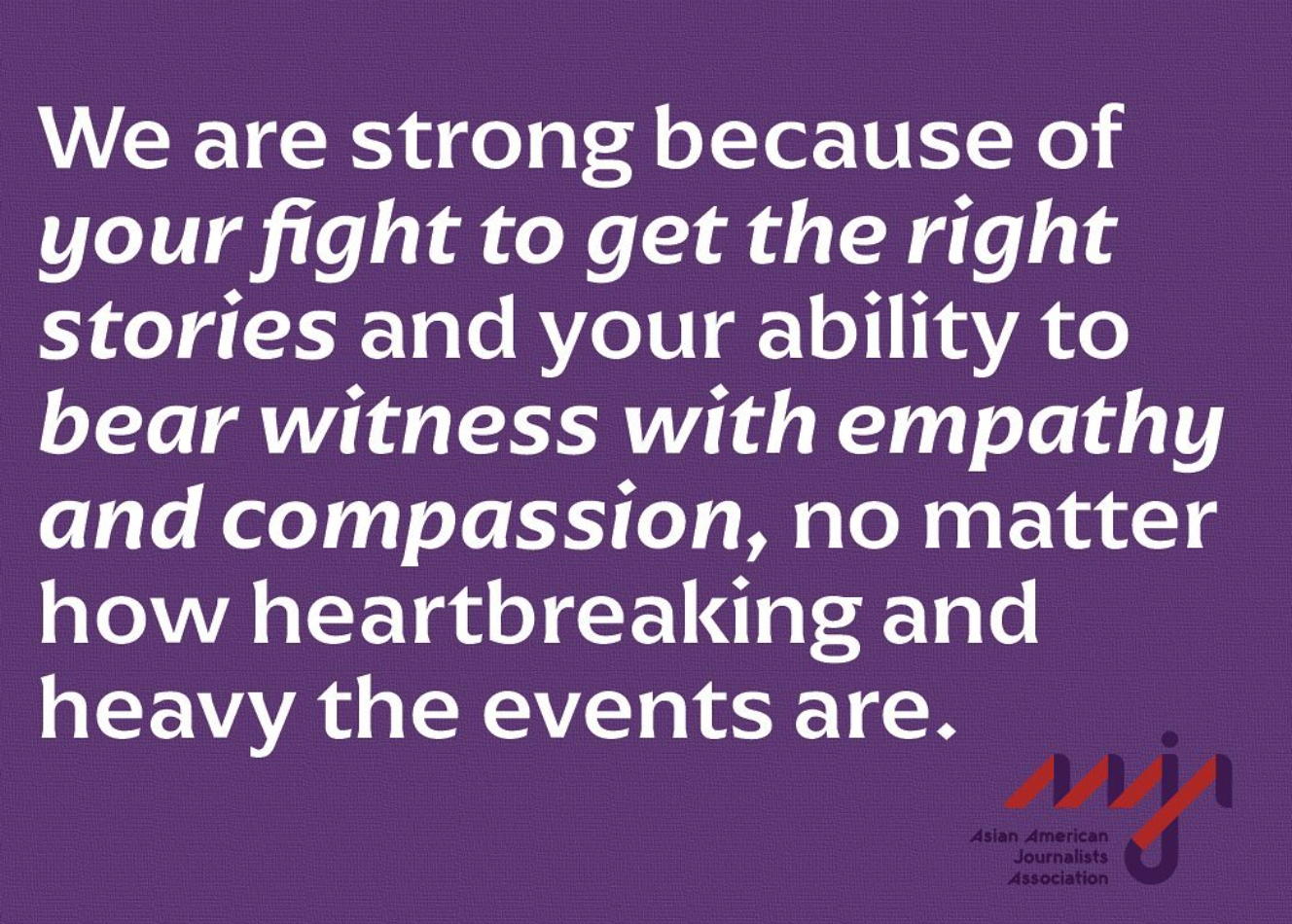
Screenshot, Facebook
40 years and counting
This year marks AAJA’s 40th anniversary. It was founded in 1981, Lee said, by journalists who felt invisible in their newsrooms and society.
In early 2019, the organization hired executive director Naomi Tacuyan Underwood, who has a background in community organizing.
AAJA currently has more than 1,800 members and an annual operating budget of $1.4 million, Lee said.
It’s not easy to offer guidance for a group that includes people from 50 countries with various backgrounds, immigration and migrant stories, said Jessica Xiao, AAJA’s communications and engagement associate. It’s constantly evolving, and so is AAJA’s work.
But they were ready to respond to the Atlanta shootings because of work they’d already done.
Media Watch advocates for fair coverage of Asian Americans and Pacific Islanders and calls out inaccurate, stereotypical and racist coverage, including in February 2020, when AAJA urged more careful coverage of the coronavirus.
As Asian Americans have been increasingly targeted and attacked during the pandemic, AAJA created programming around mental health. It built AAJA Studio in 2020, with AAPI experts available to comment on the news and make sure Asian Americans and Pacific Islanders were part of coverage and not just subjects of it. AAJA also spent the last year building a rapid response team to cover and respond to the news around the pandemic.
The week of the shooting, AAJA had planned a social media campaign to highlight anti-Asian racism and crowdsourced coverage of incidents.
After the shootings, as AAJA stepped up to guide coverage, Lee said something Tacuyan Underwood remembers.
“This moment chose us.”
“I think we were very convinced of that,” Tacuyan Underwood said. “That this really is what AAJA is about.”
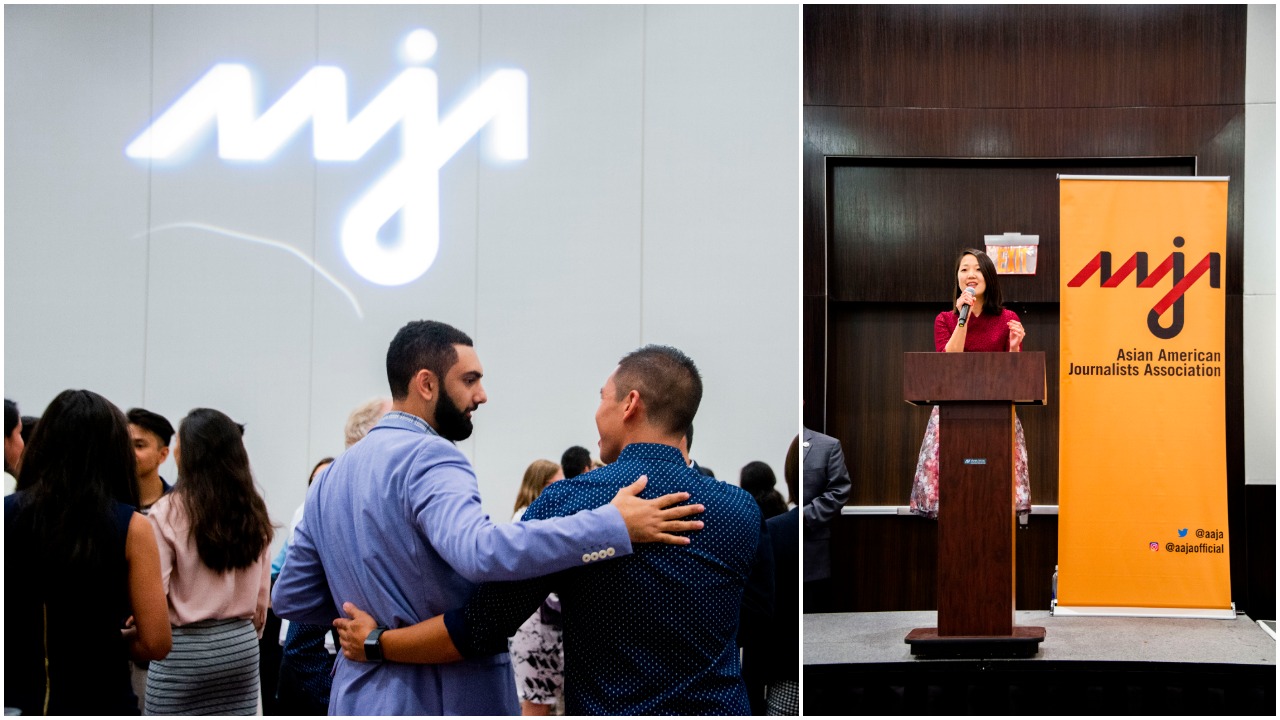
Photos from the opening reception of AAJA’s 2019 convention including, at right, AAJA President Michelle Ye Hee Lee. (Images courtesy AAJA)
We live it
The night of the shooting, the Post’s Dungca stayed up texting Julia B. Chan, managing editor of KQED in San Francisco and AAJA’s vice president of civic engagement. Dungca tweeted about the history of anti-Asian hate. What happened that day wasn’t just about what happened that day.
don’t just check on your AAPI friends. read up on the Chinese Exclusion Act, US occupation of the Philippines, Japanese internment camps. listen to AAPI women when they talk about the racist, sexualized messages they’ve heard all their lives. we’re all tired and it’s just not new
— Nicole Dungca (@ndungca) March 17, 2021
By the next morning, the Post’s Lee tweeted a thread about mental health, which AAJA soon shared in a statement with members.
To all the Asian American and Pacific Islander journalists logging on/showing up to work this morning, feeling shook, horrified, exhausted and invisible, I see you and you’re not alone. 1/
— Michelle Ye Hee Lee (@myhlee) March 17, 2021
Staff and board members flagged news coverage in the association’s Slack. They started hearing from members about discussions happening in newsrooms, including whether to call the businesses that were attacked “spas” or “massage parlors.” AAJA’s executive team, made up of women, understood the racialized gender dynamics newsrooms were reinforcing.
AAJA used its guide to talk about the hypersexualization of Asian women and the history of anti-Asian hate, including this guidance:
Take caution with language in news coverage that could further fuel the hypersexualization of Asian women, which has been linked to violence and discrimination, or stigmatize sex workers. In describing the businesses affected by the shootings, newsrooms should describe them accurately, avoiding uncorroborated or poorly corroborated references. We recommend they be described as “spas,” “businesses,” or by their proper names: Young’s Asian Massage, Aromatherapy Spa and Gold Spa.
And when a member created a video pronunciation guide for the Chinese names, AAJA used it and added one for the Korean names, then distributed both to a wider audience to help journalists on air correctly say the names of the victims.
That video got 873,000 views. Coverage guidance was retweeted more than 2,000 times, AAJA’s Xiao said, with more than 1 million impressions. That’s significantly higher than normal engagement. AAJA generally attracts a few hundred Twitter followers a month, Xiao said. In March, it grew by 4,500.
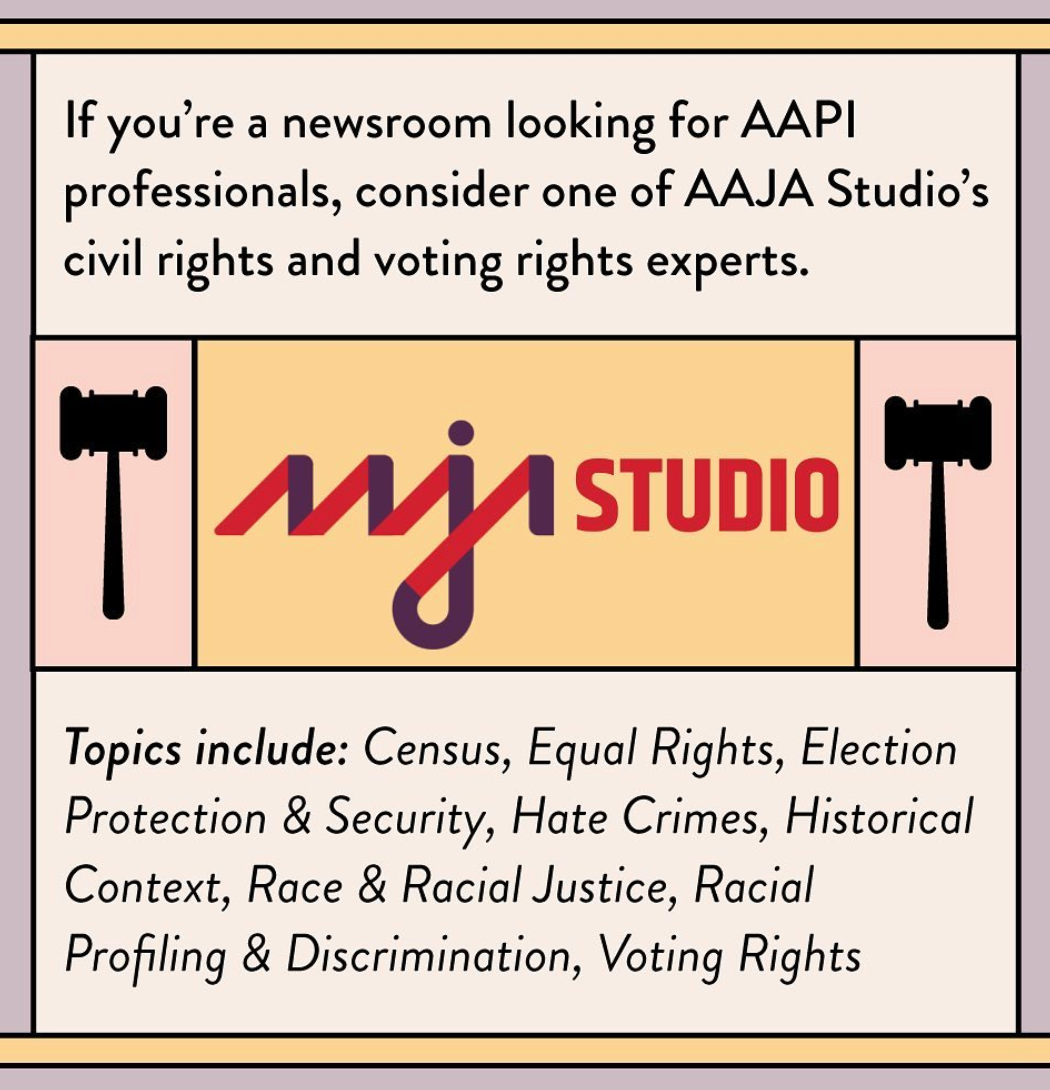
Screenshot, Instagram
Connections
AAJA’s guidance made its way into newsrooms thanks to members, including journalists at the Atlanta Journal-Constitution, which began adjusting coverage based on feedback as the news cycle continued, said Leroy Chapman, AJC’s managing editor. The newsroom’s leadership met with AAJA to discuss local and national coverage of the killings.
Two common issues they heard about: representation and community connections.
“I think all of media is having to take a look at those things when you arrive at moments such as these when it helps to have pretty firm established connections,” Chapman said. “We needed more of them and we’re developing more of them.”
Joanie Vasiliadis, TEGNA’s vice president of digital content, shared AAJA’s guidance with TEGNA’s news directors and digital directors. The broadcast company, which is working with Poynter on a six-week inclusive journalism program, has learned that breaking news situations aren’t the best environments for stepping back and asking if coverage is representative and inclusive.
“When we’re in that situation, to have an organization like AAJA put out a guide that forces us to pause … it lets us do a check of our work and helps us move forward more responsibly,” Vasiliadis said. “In a perfect world, our brains are hardwired to do those things in conjunction, to act quickly with these inclusive practices in mind, but I think everyone in news knows that we have a ways to get there.”
AAJA’s guidance went beyond just newsrooms, KQED’s Chan said.
“Humans were using our guidance on how to talk about this in their families, with their friends.”
That includes actress Drew Barrymore, who shared AAJA’s work in a list of resources on her television show.
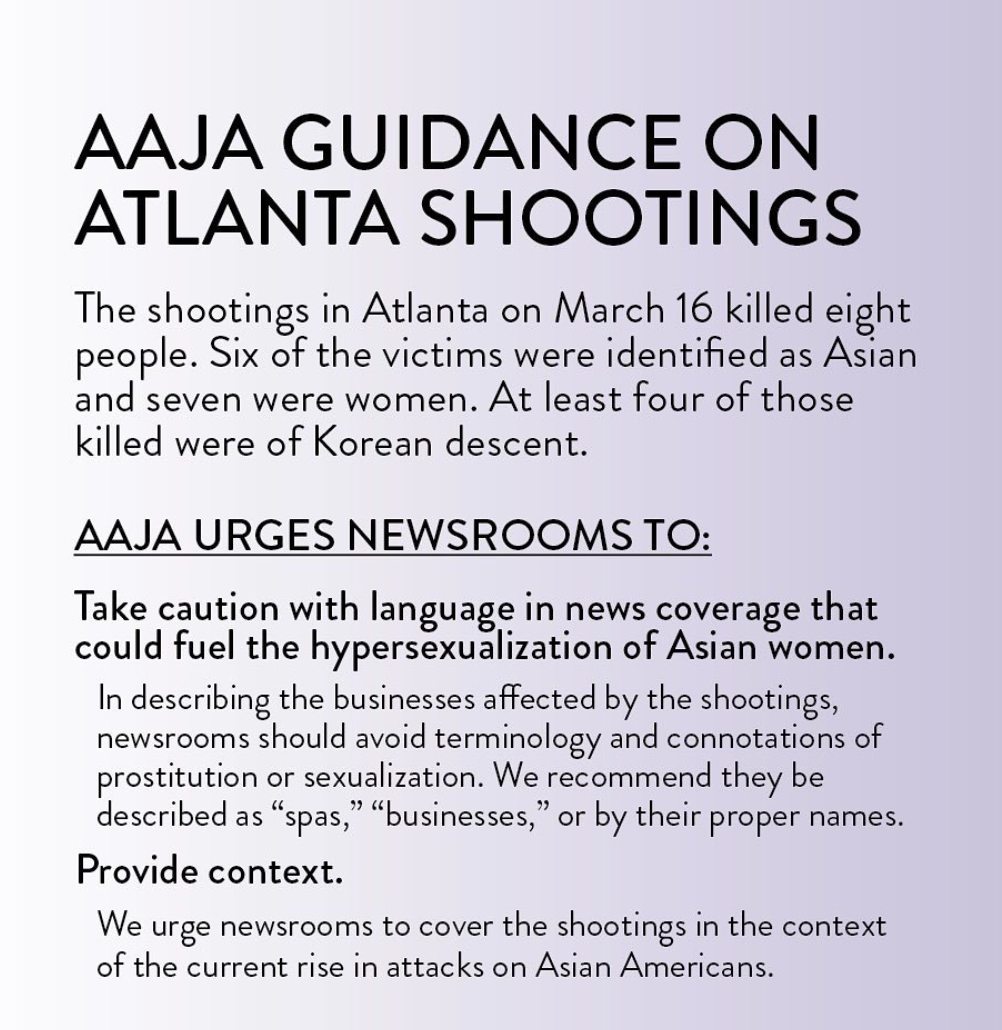
(Screenshot, Instagram)
The news wrecked me that day
Shirley Qiu wasn’t in a fast-paced newsroom during and after the Atlanta shootings. Qiu, AAJA’s vice president of communications, works for the American Press Institute and had the flexibility to slow down, absorb the news and focus on AAJA’s work.
“I don’t know what I would have done without it,” Qiu said. “The news just really wrecked me that day.”
Covering a story and helping to shape its coverage was a way of processing the killings in Atlanta, the Post’s Dungca said. But not all newsrooms wanted their Asian American and Pacific Islander journalists covering the story. After hearing from members at an already planned mental health event the night after the shooting, AAJA issued a statement encouraging newsrooms to empower their journalists. It read, in part:
Since the shootings, we have heard some deeply concerning problems in newsrooms across the country, including in Atlanta.
- “Are you sure your bias won’t show if you cover the Atlanta shootings?”
- “You might be too emotionally invested to cover this story.”
We have heard from broadcast members — and from members across newsrooms who volunteered to cover the Atlanta shooting — who have expertise, language skills, and the cultural competency in the community, but were not assigned. AAJA urges newsrooms to offer coverage opportunities to AAPI journalists who are uniquely positioned, sourced and skilled to cover the unfolding news — and who want to be a part of it.
AAJA saw solidarity from fellow journalism organizations, including NLGJA, NAHJ, NAJA, and NABJ, Lee said, which all tweeted support and encouraged people to donate to AAJA or the therapy relief fund it helped create.
It’s natural for those organizations to support each other, said Alberto Mendoza, outgoing executive director of the National Association of Hispanic Journalists. Following the Atlanta shootings, several industry groups put out a joint statement denouncing anti-Asian racism. Mendoza sees more opportunities for these organizations to work together and amplify each other’s messages.
“How can we talk about mental health in communities that don’t address it? How do we talk about immigration? Health disparities?” he said. “I think there’s going to be a bigger move in really still talking about how it affects us but not to be so siloed. It’s obvious that the intersectionalities are far greater in the populations where we come from and who we’re also trying to connect with.”
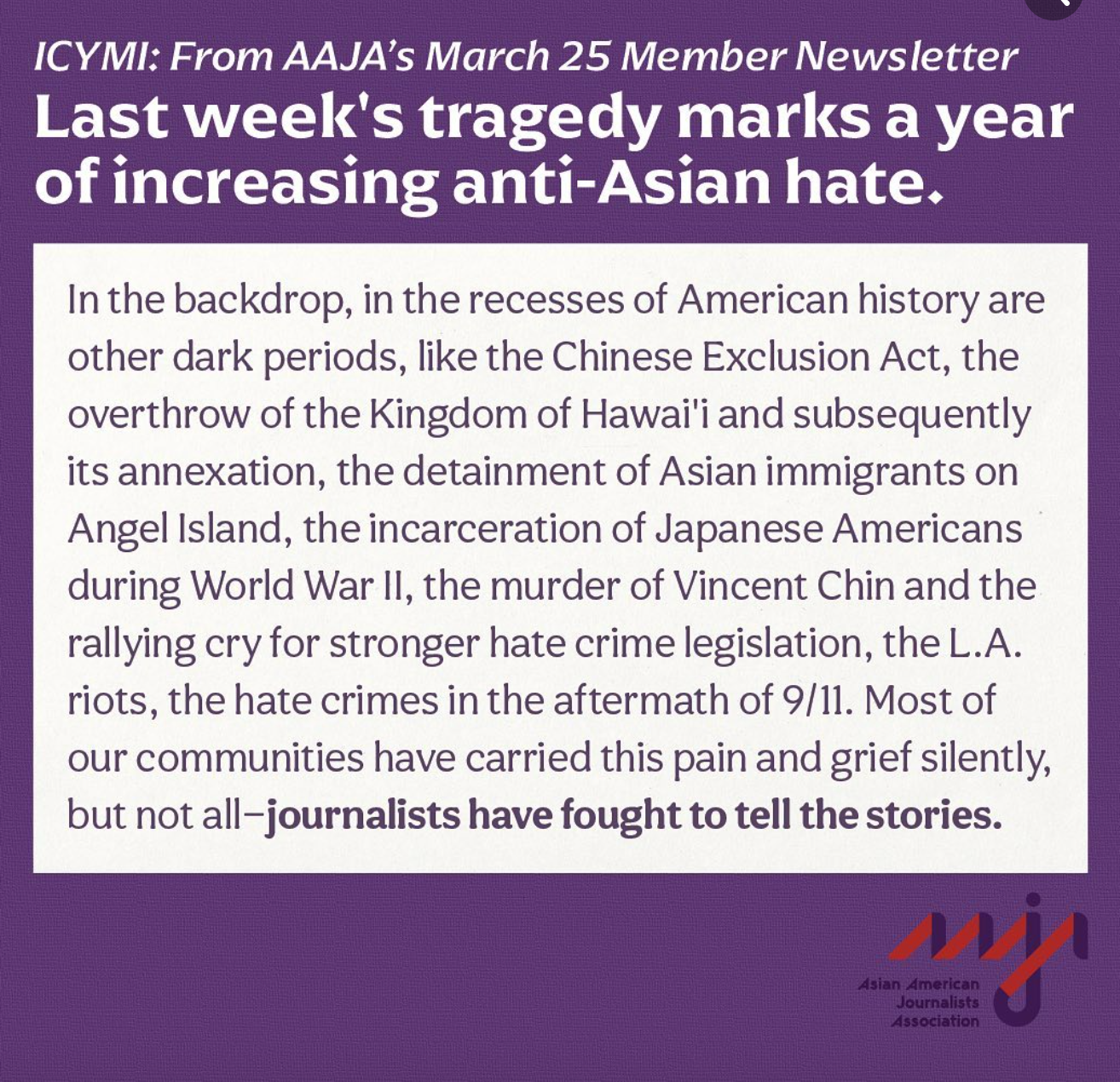
Screenshot, Facebook
The next 40
AAJA’s response to the Atlanta shootings, to increased racist attacks and violence during the pandemic, is one that came naturally for some members, AAJA’s Tacuyan Underwood said.
“A lot of this is generations of lived experience.”
In 40 years, AAJA has established itself, grown, developed leadership training and helped set industry standards.
The last year showed more of the work ahead.
“The conversation around systemic racism and the inertia in our industry that really holds journalists of color down or leaves journalists of color with the burden of creating change for ourselves, that is what fundamentally needs to change,” the Post’s Lee said, “and that means we need a wholesale rethinking of who is in power, who is making decisions.”
AAJA is planning conversations that examine the relationships between AAPI communities and Black communities, she said, “and how journalists can either amplify or refute the wedge that’s often shoved between our two communities.”
The organization is hosting several events in May in honor of AAPI Heritage Month. It’s working on an overhaul of its style guide, Lee said, upgrading AAJA Studio to train more expert sources and working on a new strategic plan with an eye toward the next 40 years.
“The AAPI experience is an American experience among many American experiences,” Tacuyan Underwood said.
Now that there’s increased awareness about violence against Asian Americans and Pacific Islanders, AAJA hopes to guide journalists toward more nuanced and sophisticated coverage of those American stories.
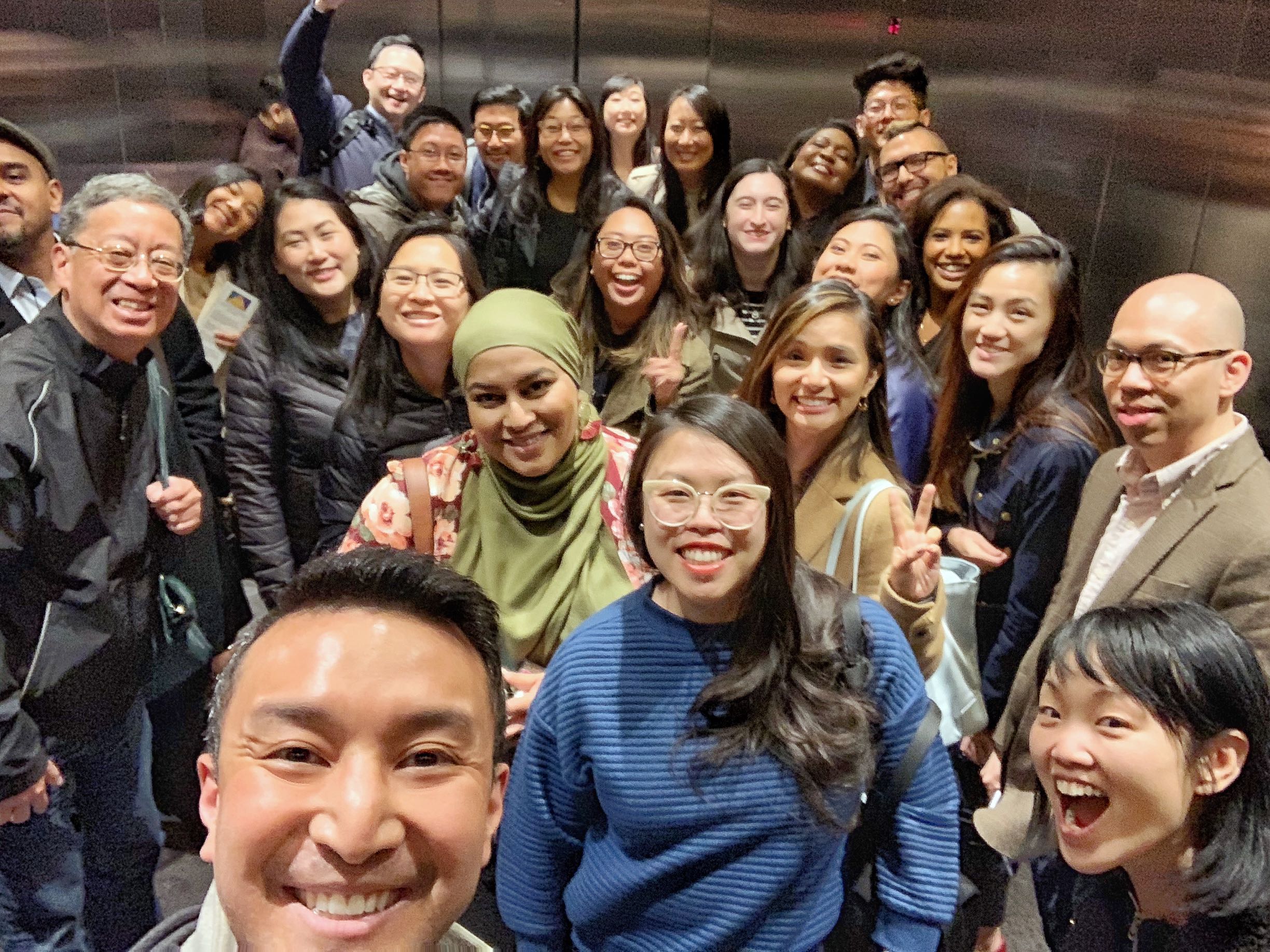
From AAJA’s Executive Leadership Program. (Courtesy: AAJA)
More from Poynter:
- AP Stylebook expands Asian American terms, revises entry on disabilities
- The rush to report on Atlanta-area shootings amplified bias in news coverage
- Here’s how to start being a battery ally
- Introducing The Collective: A newsletter for passing the mic on the path to equity
- Many newsrooms are now capitalizing the b in Black. Here are some of the people who helped make that happen.







